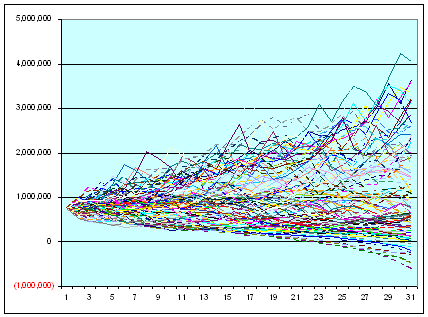Hi Halo,
Yes, the new one is somewhat more conservative than the old one, for the reasons below.
Keep in mind that if you have used the (new or old) program to find a 100% safe rate, then by definition you have a solution that is hard against the edge of failure for at least 1 cycle. So anything that changes -- including the addition of 2003-2005 data that weren't yet available in the old version-- could push that one on the edge across to failure.
A failure by a penny the very last year of the cycle is treated the same as a massive failure, so look at the chart on the right in the standard run to see if the failures you are seeing are nearly zero, or are bigger.
Also, you might find the following useful in understanding the differences, especially those that could push a scenario that was successful by a dollar before to a failure by a dollar now:
_________________________________________________
First, from the change notes at
http://firecalc.com/notes.htm (linked at the bottom of the FAQ):
... don't look for it to match exactly the results from the original, although it will be close. The algorithm is basically the same, but was redeveloped from scratch, and uses newer data and different default settings.
_________________________________________________
I no longer include partial "cycles" since 20-30 cycles that aren't the full x years will paint a falsely optimistic picture.
_________________________________________________
Current year withdrawals are taken at the beginning of the year, but since they will be used to meet currrent year expenses, they are adjusted for the actual inflation in the current year. (Note: I think this may be the biggest impact for you. If you are taking 50k and growth averages 8% and inflation averages 5%, then the program is withdrawing $2500 more to provide you with the spending money you'll need for the year (as did the old version), but you're no longer getting the 8% growth on the $52,500k ($4,200).
Workaround: FIRECalc assumes you really mean you need to be able to spend every bit of that $50,000 you entered as a spending requirement, every single year for the duration of your retirement.
If you are more flexible in your spending, then the optional spending model (shown near the top in the Advanced version) makes more sense. It allows fluctuations in spending, based on portfolio value, and is almost impervious to a failure in the standard FIRECalc sense. (It's idea of failure is your portfolio ends up being worth less than when you started.) Or as stated in the FAQ:
FIRECalc seeks to answer the question, "With what I have today, and what it costs me to live, can I retire and maintain the same lifestyle?" So it works with today's portfolio. Since your lifestyle costs will change with inflation, the future withdrawals are adjusted accordingly, and FIRECalc tells you how often such a withdrawal plan would have worked.
But planning is different than practice. In Work Less, Live More, author Bob Clyatt points out that most people will adjust their spending in response to the value of their nest egg. If you choose, FIRECalc will base withdrawals on the portfolio value at the time of each annual withdrawal, instead of the starting portfolio.
_________________________________________________
FIRECalc has data through 2005. (This means full 40 year cycles starting in 1962-1965 started being considered in the process, or full 30 year cycles starting in 1972-75. Those were some lousy years, and would also make things look a bit worse for your model.)
_________________________________________________
Also, let me repeat a few responses that I wrote during the beta test:
_________________________________________________
Old system: withdrawal taken at end of year, and was adjusted for inflation, but the portfolio grew with the $$$ still in there the whole year.
New system (and thinking behind it): Your spending will be adjusted for inflation during the year, as prices will rise as you go along. But you'll withdraw the cash at the beginning of the year, because you can't eat air for 12 months waiting for the withdrawal.
Neither is really true -- you spend as you go -- but the granularity is in years, and I had to pick.
_________________________________________________
A bigger change in data. As did others who research this sort of data, I've switched to the long interest rate, which more closely approximates what people earn on the fixed portion of their portfolio, instead of commercial paper, which is more applicable to institutions than mere mortals.
The new data is much more stable, but it will also make your results change from the old data. (Look at the differences graphically at
http://firecalc.com/faq.htm#fixedchoice.)
_________________________________________________
Hope this helps explain...
dory36

